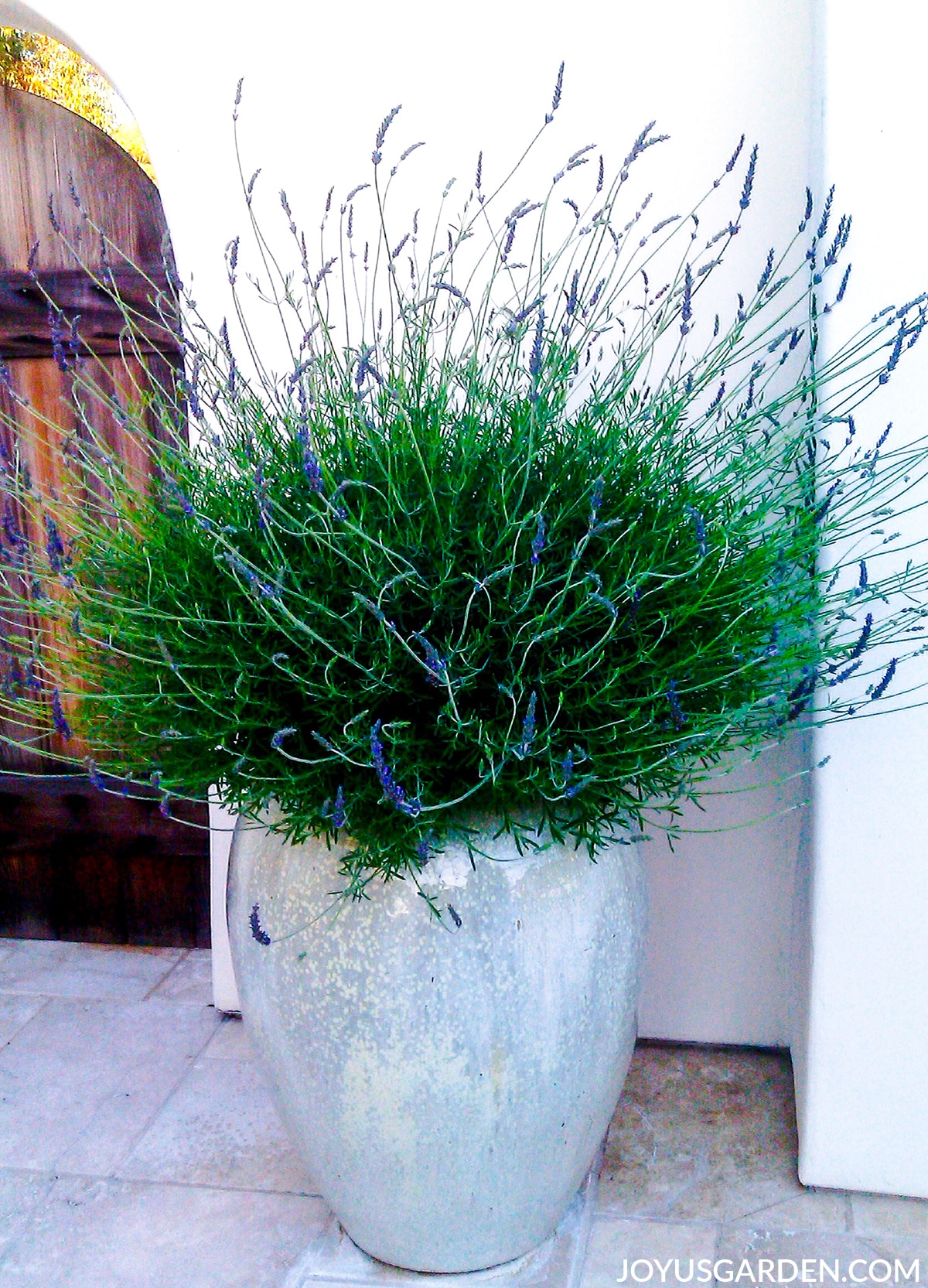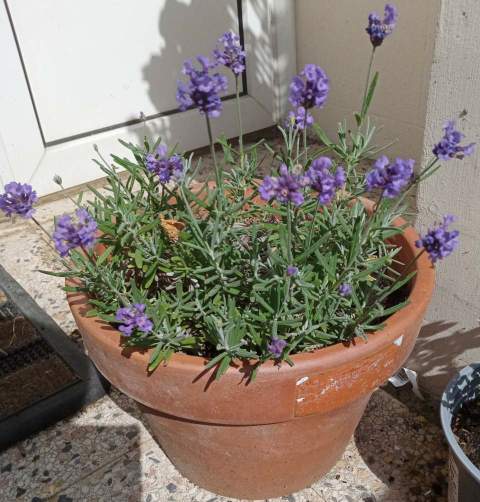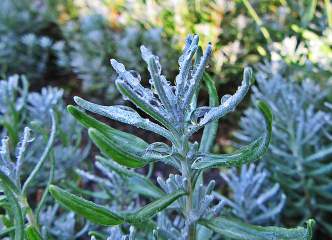During the first two years after planting, lavender plants in pots only require weekly watering. Once fully grown, potted lavender plants just require a light watering once every two weeks if there hasn’t been any rain.
Lavender is a native of the Mediterranean, where it grows well in sandy soils with low nutrients, full sun, and little water.
Lavender plants in pots typically die because they are overwatered. One of the first signs of an overwatered lavender plant is an overall appearance of wilting and browning foliage.
Some gardeners misjudge the amount of water the lavender is receiving at this time and wind up making the situation worse by watering it more frequently.
Always water your lavender in the morning to give the soil time to dry during the day and prevent excessive moisture from remaining overnight.
You may find out exactly how frequently you should water potted lavenders in the first year after planting, how frequently to water lavenders that are already established, how to prevent overwatering lavenders, and what kind of pot is best for lavenders by continuing to read.
Table of Contents
How Often to Water Lavenders in Pots
As a result, when grown by gardeners, lavender plants are much more susceptible to overwatering than underwatering.
In most temperate areas, lavender plants that have been planted in the ground for at least two years usually do not require watering, and only very rarely do they in drought-like conditions.
However, lavender plants grown in pots require a little more care and attention than lavender plants grown in the ground since dirt in pots dries out faster than soil in plants grown in the ground.
If there hasn’t been any rain and there hasn’t been much sun, potted lavender plants should be watered about once every two weeks during the growing season.
Water in the morning at the plant’s base, making sure not to wet the leaves.
Potted lavender plants won’t require any more watering if there has been some rainfall and some cloud cover.
This may appear to be careless gardening, but because lavenders are descendants of Mediterranean plants, they can survive droughts and poor soils when other plants would not!
All lavender kinds and their many hybrids should be watered according to the same guidelines.
The English varieties are much more tolerant of frosts and cold winters, whereas the more delicate Spanish and French varieties will need to be brought inside to a frost-free environment over winter. This is the only significant difference in care between potted English lavenders and potted french or Spanish lavenders.
All types can withstand drought, do well in containers, and, with the right care, will yield lovely scents and spectacular flowers.
Newly Planted Potted Lavenders Require More Water (but don’t over water)
When you move lavenders to an environment that is drastically different from their current one, such as from the garden center to your own backyard garden in a different pot, they may experience transplant shock. This often occurs around a week after planting.
Transplant shock may appear as drooping leaves and stems, giving the appearance that the plant is not getting enough water, but this is only a stress response to its new habitat and should only last a week or so.
After placing the lavender in the pot, hydrate the surrounding soil around its base, and place it in a sunny area.
The symptoms of shock will subside if you resist the urge to water it again during the first week after planting and give it time to get used to its new surroundings.
It is advisable to water a newly planted pot of lavender once a week for the first four weeks while the roots are developing.
In the warmer summer months, you can cut back on watering after four weeks to once every two weeks, although you won’t need to if it has just rained heavily. More water won’t benefit them at all.
Until September, when the temperature drops and the soil doesn’t dry out as quickly, water fresh lavender plants every two weeks (depending on the amount of rainfall) as they get ready for a time of winter hibernation.
If you have English lavender, you can keep the potted lavender outside over the winter and it will get enough moisture to survive.
On the other hand, French or Spanish lavenders must be brought inside throughout the winter because they cannot stand frost. Give them a healthy drink once every six weeks till spring arrives even though they won’t need much water over the winter.
It pays to be patient because lavenders always put on their best bloom display after the first year of growth.
Choosing the Right Pot for Watering Lavenders
From a watering perspective, picking the appropriate pot for lavenders is essential. To ensure that water may drain as freely as possible, the optimal pot for lavenders must have numerous holes in the base.
The lavender roots will benefit if you fill the pot’s bottom with approximately an inch of gravel to create air pockets, prevent the soil from compacting at the bottom of the pot, and speed up water drainage.
You run the risk of root rot, which will destroy the plant, if the roots of the lavender are left in moist soil for an extended period of time.
For a mature lavender plant, the pot must have adequate drainage, be 16 inches wide, and have a depth of at least 12 inches.
Water can exit easily and drain away correctly rather than accumulating beneath if you can keep the pot off the ground with some pot feet (available from garden stores) or propped up with stones.
Do not make this error!
A common error with potted lavenders is to place a saucer or plate at the bottom of the pot to prevent water from pouring out, especially if the plant is inside. Water accumulating in the pot might cause saturated soil, which will cause root rot and kill the lavender.
How to Avoid Over Watering Lavenders in Pots
The biggest danger to your lavender is overwatering. In wet soil, lavender will sadly experience root rot and eventually perish. There are things you can take to lessen this risk, though:
- Lavenders must be potted in a well-draining medium that is composed of two thirds sand or grit and one third compost. This mimics the soil drainage patterns found in the Mediterranean, where they naturally flourish.
- Make sure your pot has drainage holes in the bottom and that there is a layer of gravel at the bottom to prevent the holes from becoming clogged with compacted soil. The pot should ideally be supported so that water does not collect beneath it.
- Lavender needs direct sunlight (preferably more then 6 hours per day during summer). This will keep the soil’s conditions ideal for the plant and assist in drying out considerable moisture.
- Lavenders should only be watered twice a week, and you shouldn’t water them if there has been a lot of rain or if it is cloudy outside.
The four techniques listed above should help your lavender flower nicely and release its distinct, summery scent.
Conclusion
Key Learnings:
- Water established potted lavender plants twice weekly in the summer if they are dry and don’t need it if there have been many cloudy days with heavy rain in the spring and summer.
- Lavender plants that have just been planted require watering twice a week for the first four weeks after planting, then merely once a week for the first year. Once established, during the growing season, water once every two weeks.
- If English lavender is left outside, you won’t need to water it at all throughout the winter because they can withstand frost and get enough water to survive.
- Due of lavender’s drought resistance and dislike of moist soil, overwatering is always a bigger issue than underwatering.
- French and Spanish types need to be kept indoors throughout the winter to avoid frost, and they just need a little water every six weeks.
- Make sure your lavender is located in a sunny area and is planted in sandy soil with good drainage.
FAQ
Should I water my lavender every day?
Because lavender is drought-tolerant, mature plants don’t require constant watering like other garden plants do. They may become susceptible to root rot and fungus if they receive too much water. Young lavender plants need to be watered frequently until they become established (either by irrigation or adequate rainfall).
How often do you water lavender in hot weather?
Lavenders are drought-tolerant plants that do well in hot, arid conditions. If there hasn’t been much rain, established lavender just needs watering once a week in hot weather with a generous soak. Every two weeks, water lavender plants in pots and other containers.
How often should potted lavender be watered?
Lavender Care Instructions. After planting, water your plants once or twice a week until they are established. Water mature plants once or twice weekly until harvest, then every two or three weeks after buds emerge. (Overwatering is frequently indicated by yellowing foliage.)
How often do you water a potted lavender?
Lavender Care Instructions. After planting, water your plants once or twice a week until they are established. Water mature plants once or twice weekly until harvest, then every two or three weeks after buds emerge. (Overwatering is frequently indicated by yellowing foliage.)



